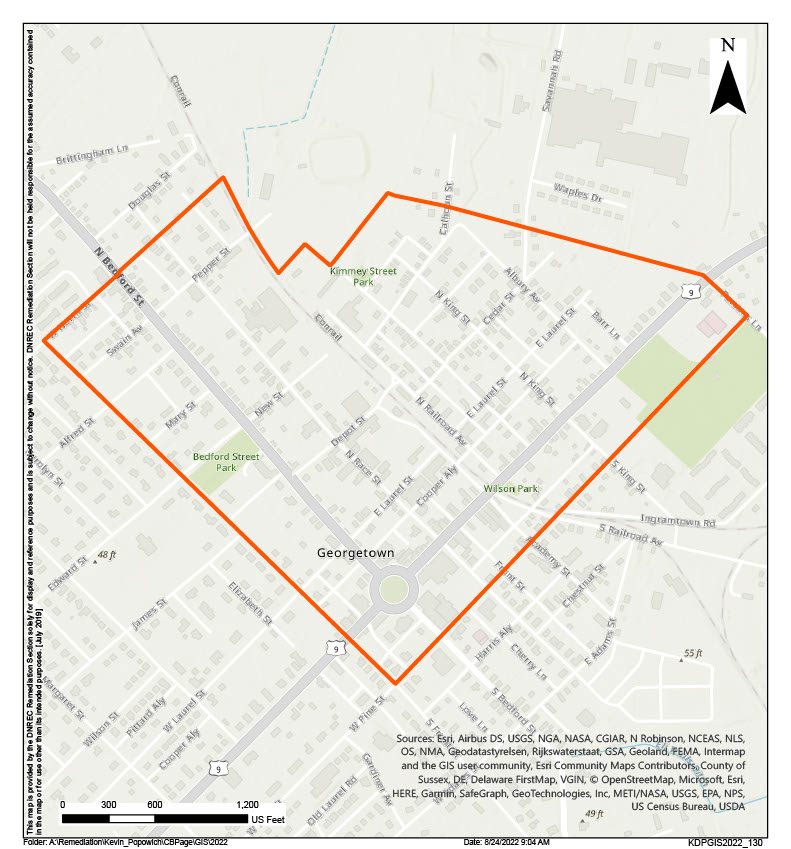The U.S. Environmental Protection Agency (EPA) has added the Georgetown North Groundwater Site to the Superfund National Priorities List (NPL). The NPL is EPA’s list of priority sites requiring evaluation for possible remediation from releases of hazardous substances, pollutants or contaminants.
Qazi Salahuddin
Administrator
DNREC Remediation Section
302-395-2600
Rick Galloway
Project Manager
DNREC Remediation Section
302-395-2600
Michael Globetti
DNREC Media Relations Manager
302-739-9902
Angela Ithier
EPA Community Involvement Coordinator
215-814-5248
Connor O’Loughlin
EPA Site Assessment Manager
215-814-3304 or 800-438-2474
Anthony Iacobone
EPA Remedial Project Manager
215-814-5237
David Sternberg
EPA Press Officer
215-814-5548
The EPA announced its decision to list the site on the NPL and published details in the Federal Register (87 FR 55299) in September of 2022.
The Georgetown North Groundwater Site was added to the Superfund National Priorities List due to the identification of a groundwater plume containing primarily tetrachloroethylene, also known as perchloroethylene (PCE), trichloroethene (TCE), and benzene impacting municipal drinking water wells in the Town of Georgetown.
The EPA held two question and answer sessions to help the Georgetown community have their questions answered by EPA staff — a virtual session on Thursday, April 14, and an in-person session on Wednesday, April 20.
Public drinking water currently provided by the Town of Georgetown is treated to remove the contamination, including PCE, TCE and benzene. The finished drinking water meets all applicable federal and state standards. The most current testing completed in August 2021 indicates the Georgetown municipal drinking water continues to meet the applicable standards. The water is safe to drink and for household uses such as showering and washing laundry.
Listing the site on the NPL makes it eligible for remedial action financed under the federal Superfund program. This will allow EPA to use Superfund authority and resources to investigate and remediate the contamination and protect human health and the environment in Georgetown.
 The Georgetown public wells used for drinking water purposes have had repeated detections of volatile organic compounds (VOCs), including benzene and tetrachloroethylene, also known as perchloroethylene (PCE), over the safe drinking water standards, also known as maximum contaminant levels (MCLs), periodically since the mid-1980s. DNREC determined that the presence of VOCs in the groundwater posed a concern for human health and the environment, and consequently determined that the Site needed to be remediated under the Delaware Hazardous Substance Cleanup Act (HSCA). Over the years, DNREC has identified, investigated and conducted remedial actions at a number of HSCA Sites in the vicinity of the Georgetown public wells, which are located on King Street.
The Georgetown public wells used for drinking water purposes have had repeated detections of volatile organic compounds (VOCs), including benzene and tetrachloroethylene, also known as perchloroethylene (PCE), over the safe drinking water standards, also known as maximum contaminant levels (MCLs), periodically since the mid-1980s. DNREC determined that the presence of VOCs in the groundwater posed a concern for human health and the environment, and consequently determined that the Site needed to be remediated under the Delaware Hazardous Substance Cleanup Act (HSCA). Over the years, DNREC has identified, investigated and conducted remedial actions at a number of HSCA Sites in the vicinity of the Georgetown public wells, which are located on King Street.
Water samples collected in 1987 from Georgetown Public Well No. 1 and a nearby Perdue Farms well reportedly had low levels of benzene above groundwater maximum contaminant levels (MCLs).
Subsequently in 2019 and 2020, a Preliminary Assessment (PA) and Site Inspection (SI) were performed within the Georgetown North Groundwater Site (known also as Georgetown Groundwater Operable Unit (DE-1407)). A 2019 PA conducted by DNREC included the review of untreated water analytical results for the Georgetown public wells from 2008 to 2017 that confirmed the presence of PCE and TCE above the state MCL of 1 microgram per liter (ug/L) or the federal MCL of 5 ug/L. The results from the PA were as follows:
During the 2020 site inspection, PCE was detected in Georgetown Public Well 2R at 4.3 ug/L and TCE at 2.1 ug/L, above the respective state MCLs.
The Town of Georgetown installed an air stripping system on the impacted public wells in 2019 and the treated water meets safe drinking water criteria. An air stripping system is a treatment process that bubbles large volumes of air through the water being treated to remove (strip out) dissolved gases and volatile substances.
An expanded SI on the Georgetown North Groundwater Site is in progress with a focus on the area immediately surrounding the Georgetown public wells to determine what direction the contamination is migrating from. Based on data collected to date, it appears the majority of the chlorinated solvent contamination is migrating from south of the Georgetown wells. The expanded SI report is expected to be completed by March 2022.
Investigations conducted by DNREC and the EPA identified the following potential sources of the contamination listed below where historical operations may have impacted groundwater. Although potential sources have been identified, the contamination has not been fully delineated or remediated. Additional sources of contamination in the groundwater also may be identified in the future as a result of EPA’s investigation.
For more information regarding previous DNREC and EPA investigations at the Georgetown North Groundwater Site and nearby area, please visit the Delaware Environmental Navigator (DEN).
Related Topics: drinking water, EPA, georgetown, groundwater, Health and Safety, superfund, waste and hazardous substances